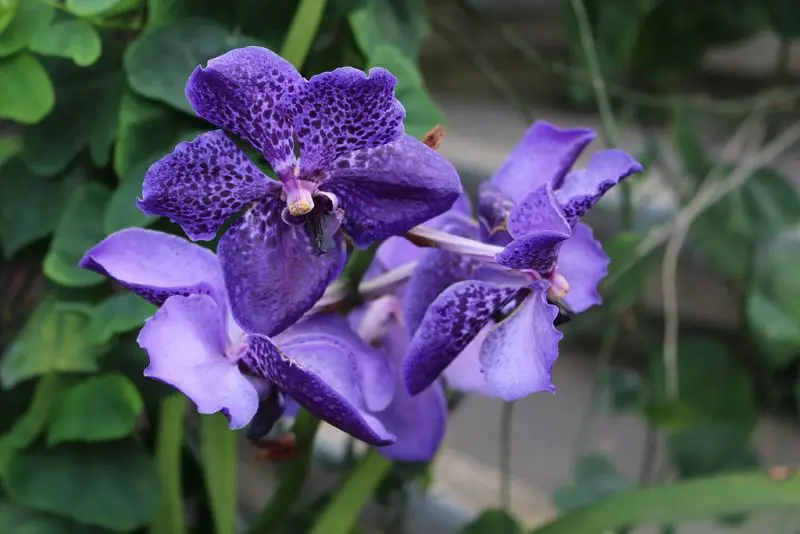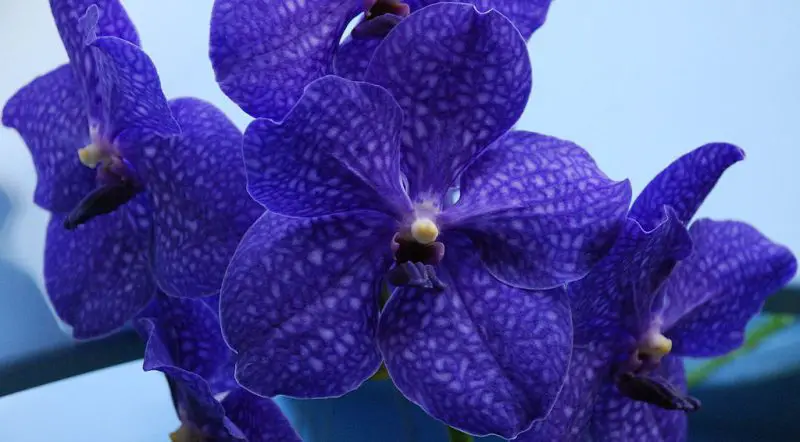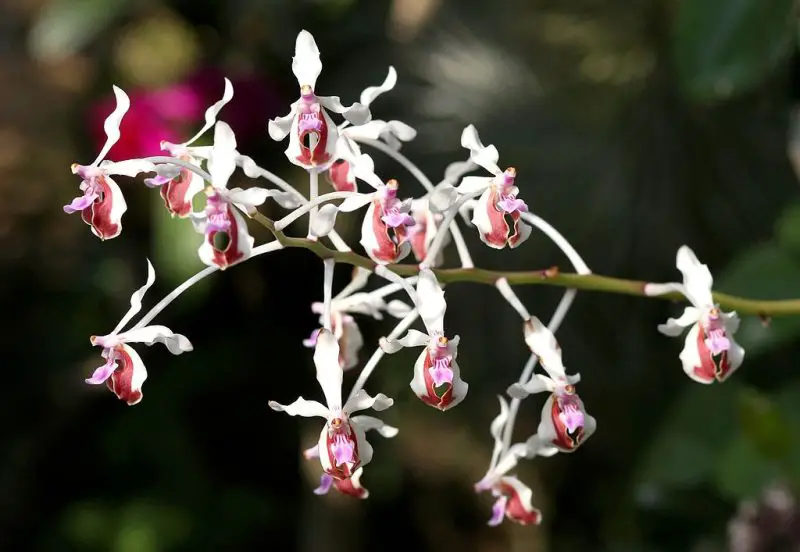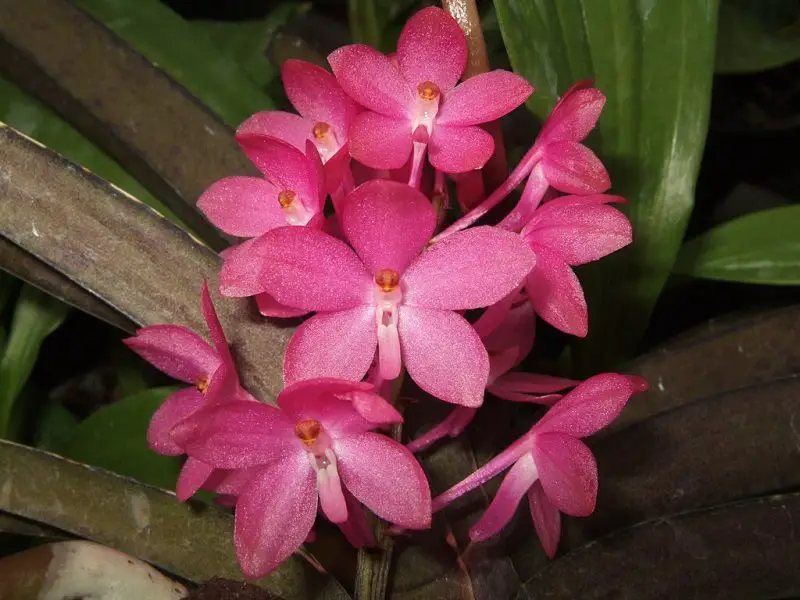
Explore the stunning types of Vanda Orchids, from the rare blue Vanda to the fragrant Vanda cristata. Discover your favorite!
What is a Vanda Orchid? Key Takeaways:
Dive into the vibrant world of Vanda orchids! These botanical marvels are not just plants; they’re a burst of color, form, and fragrance.
With their stunning spectrum from royal purples to sky blues, the types of Vanda orchids are a testament to nature’s artistry.
Each bloom is a celebration, inviting both novices and connoisseurs alike to explore their exotic allure.
Exploring the Types of Vanda Orchids

Vanda orchids are a fascinating and diverse group of plants that have captivated the hearts of orchid enthusiasts worldwide.
Known for their stunning, vibrant flowers and unique growth habits, Vandas are a prized addition to any orchid collection.
In this blog post, we’ll dive into the different types of Vanda orchids, their care requirements, and some frequently asked questions to help you better understand and appreciate these beautiful plants.
According to Wikipedia:
Vanda, abbreviated in the horticultural trade as V., is a genus in the orchid family, Orchidaceae. There are 90 species, and the genus is commonly cultivated for the marketplace. This genus and its allies are considered to be among the most specifically adapted of all orchids within the Orchidaceae. The genus is highly prized in horticulture for its showy, fragrant, long-lasting, and intensely colorful flowers. Vanda species are widespread across East Asia, Southeast Asia, and New Guinea, with a few species extending into Queensland and some of the islands of the western Pacific. Wikipedia
Popular Types of Vanda Orchids

Vanda orchids boast a wide array of species, each with its own unique charm. Here are some of the most popular types:
- Vanda sanderiana (Waling-waling):Revered in the Philippines, this orchid is known for its large, striking flowers and is often used in breeding programs to create new hybrids. Dubbed the “Queen of Philippine flowers,” this species is a symbol of beauty in the Philippines.
- Vanda tricolor: This species is cherished for its tri-colored flowers, typically featuring a combination of white, yellow, and purple, making it a standout in any collection. Hailing from Indonesia, this type is celebrated for its vibrant, colorful blooms.
- Vanda coerulea (Blue Vanda): One of the few orchids with true blue flowers, it’s a highly sought-after species for its rare and captivating blooms. Known for its striking bluish-purple flowers, this species is a gem from Northeast India and China.
- Vanda denisoniana: This orchid is appreciated not only for its lovely yellow flowers but also for its pleasant fragrance, which adds an aromatic dimension to its beauty. This Southeast Asian variety is adored for its small yellow flowers with a delightful vanilla scent.
- Vanda tessellata (Checkered Vanda): Its unique checkered pattern on the petals and sepals sets it apart, making it a favorite among orchid enthusiasts. With its tan/brown petals and contrasting purple lip, this orchid is a visual treat from India to Indochina.
- Vanda Robert’s Delight: A hybrid with captivating dark purple blooms. A popular hybrid, known for its large, deep purple flowers, it’s a result of careful breeding to enhance its color and size.
- Vanda lamellata: Renowned for its compact and elegant appearance, this species can be found in Japan, Taiwan, and Borneo. This species is known for its resilience and adaptability, making it a great choice for beginners in orchid cultivation.
- Vanda coerulescens (Sky-blue Vanda): Its delicate blue flowers with a contrasting lip are highly prized for their ethereal beauty. This species enchants with its lilac blue or pink flowers and contrasting lip.
- Vanda cristata: A small to medium-sized Asian species, known for its fragrant flowers. This orchid is known for its textured lip, which adds an interesting visual element to its otherwise simple flowers.
- Vanda sumatrana: An uncommon species from Sumatra, noted for its smoky-sweet fragrances. Its rarity and unique fragrance make it a coveted species for collectors looking for something truly special.
- Vanda merrillii: The deep mahogany red flowers of this orchid are a stunning addition to any collection, offering a rich and warm color palette. Native to the Philippines, this orchid is cherished for its deep mahogany red flowers.
- Vanda liouvillei: Blooming in late winter and early spring, this orchid provides a burst of color when many other plants are still dormant. A medium-sized epiphyte that blooms in late winter and early spring, with strap-shaped leaves.
- Vanda pumila: Its small size and long-lasting flowers make it a charming choice for those with limited space. A small-sized species from Asia, known for its greenish-yellow flowers.
- Vanda javierae (Mrs. Javier’s Vanda): A beautiful white Vanda species. This white Vanda is admired for its pure and elegant blooms, adding a touch of sophistication to any orchid collection.
Each of these Vanda orchids offers a unique beauty and charm and has its own unique characteristics, making them highly sought after by enthusiasts and collectors alike
Care Tips for Vanda Orchids

Caring for Vanda orchids involves understanding their specific needs:
- Light: Vandas thrive in bright, indirect light. Avoid direct midday sun to prevent leaf scorch.
- Watering: Water once or twice a week, allowing the potting mix to dry slightly between waterings. Vandas are prone to root rot if overwatered.
- Temperature and Humidity: They prefer warm temperatures (70-90°F) and high humidity. Mist regularly or use a humidity tray to maintain moisture.
- Potting Mix: Use a well-draining mix rich in organic matter, such as a blend of bark, perlite, and sphagnum moss.
- Pruning: Regularly remove dead or damaged leaves and flowers to encourage new growth. Use sterilized tools to prevent disease spread.
Propagation Methods for Vanda Orchids

There are three main methods to propagate Vanda orchids:
-
- Dividing the Plant: When the orchid becomes overcrowded or during dormancy, gently separate the individual pseudobulbs with roots attached and replant them in separate pots.
- Taking Stem Cuttings: Cut a stem with a few leaves, remove lower leaves, dip the cut end in rooting hormone, and place it in a potting mix or hydroponic system. Keep the mix moist and provide indirect light.
- Growing Them From Seed: This method is challenging and requires specific conditions like high humidity and constant airflow. Sow seeds on a sterile medium and keep them in a controlled environment.
FAQs: Understanding Vanda Orchids
Vanda orchids are a diverse and captivating group of plants, but they can also be a bit mysterious.
To help you get to know these beautiful flowers better, we’ve compiled a list of frequently asked questions.
From the different types of Vandas to their care needs and blooming habits, we’ve got you covered.
Q. What are the different types of Vanda orchids?
A: Vanda orchids come in various types, including Vanda sanderiana, Vanda tricolor, Vanda coerulea, Vanda denisoniana, and many more.
Q. What is the rarest Vanda orchid?
A: The rarest Vanda orchid can vary based on region and demand. Vanda coerulea, also known as the blue orchid, is considered rare and highly sought after.
Q. What is the difference between Vanda and Cattleya orchids?
A: Vanda orchids are monopodial with strap-like leaves, while Cattleya orchids are sympodial with pseudobulbs and broader leaves.
Q. What is the lifespan of a Vanda orchid?
A: With proper care, Vanda orchids can live for many years, often exceeding a decade.
Q. Do Vanda orchids need to be watered every day?
A: Vanda orchids do not need daily watering. Watering once or twice a week is usually sufficient.
Q. How many times a year do Vanda orchids bloom?
A: Vanda orchids can bloom multiple times a year, depending on the species and growing conditions.
Q. How often should Vanda orchids be watered?
A: Water Vanda orchids once or twice a week, allowing the potting mix to dry slightly between waterings.
Q. How long does it take a Vanda orchid to rebloom?
A: The time for a Vanda orchid to rebloom can vary, but with proper care, it can bloom several times a year.
Q. Do Vandas like full sun?
A: Vandas prefer bright, indirect light. They can tolerate some direct sun, but protection from intense midday sun is essential.
Conclusion: Embracing the Types of Vanda Orchids A World of Beauty
Vanda orchids offer a captivating array of colors, shapes, and fragrances.
Each variety brings its own unique charm, contributing to the incredible diversity of this orchid family.
A Rewarding Challenge:
Growing Vanda orchids can be a rewarding experience. With the right care, these stunning flowers can thrive and bring a touch of exotic beauty to your home or garden.
An Invitation to Grow:
If you’re new to orchid gardening or looking to expand your collection, Vanda orchids are a wonderful choice. Their resilience and vibrant blooms make them a joy to cultivate.
A Journey Worth Taking:
Embrace the challenge and embark on your own Vanda orchid journey. With patience and care, you’ll be rewarded with breathtaking blooms that will brighten your surroundings and uplift your spirit.
Read more: Are Orchids Hard To Take Care Of? Easy Growth Formula
Learn how to care for Encyclia Orchids
This post contains affiliate links.

